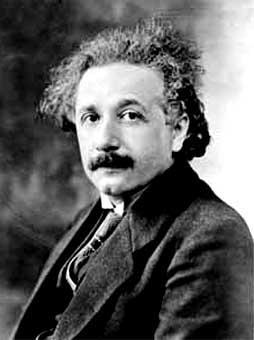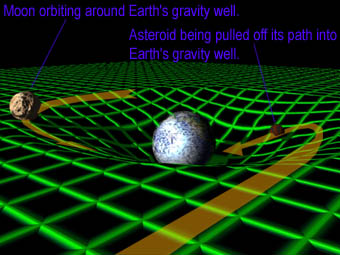Time Travel Research Center © 2005 Cetin BAL - GSM:+90 05366063183 - Turkey/Denizli
Einstein and the Universe II
The Theory of General Relativity and Beyond
 Einstein was not satisfied with his original theory of relativity and wanted to extend it to include gravity. |
After publishing his Theory of Special Relativity, Einstein began to garner much respect among physicists. However, Einstein was not satisfied with his work. He felt it was incomplete and soon started searching for new theories, first one that would include the force of gravity, then later one that would explain all of physics.
Einstein knew that his Special Theory of Relativity should be expanded to include gravity and in 1907 started to work on what would be later called his General Theory of Relativity. While he had a picture in his mind of what such a theory might look like, he found the mathematics daunting. In 1912 he wrote, " One thing is certain: never before in my life have I troubled myself over anything so much Compared with this problem, the original theory of relativity is child's play."
To help him learn the complicated mathematics necessary, Einstein enlisted an old friend of his, Marcel Grossmann, who was also teaching at Zurich Polytechnic. They wrote several articles together, with Grossmann handling the math and Einstein the physics. In 1913 they published Draft of a Generalized Theory of Relativity and of a Theory of Gravitation. The paper contained several errors, but still created a stir in the scientific community. Einstein was invited to join the prestigious Prussian Academy of Sciences. He accepted the post and moved to Berlin, Germany, alone. He and his wife Mileva had drifted apart over the years, and she did not follow him. They soon divorced.
The Prussian Academy at the heart of the German Scientific world and Einstein had access to some of the best mathematicians in Europe. By 1915 he had found his errors in the draft paper and published a new version. What it said would overturn what was known about the physical laws of the universe.
The General Theory of Relativity
Einstein started his paper by saying that mass is equivalent to inertia. What this means is that the gravity that presses you down in your seat is the same force that you feel when you are pulled forwards in car when the driver hits the breaks. Your chest presses against the seatbelt for the same reason your bottom pushes against your chair. Since the time of Isaac Newton, physicists had always thought of gravity as a force that pulled things toward an object. The bigger the object, the stronger the pull. The earth was a big object so it had enough pull to hold objects - people, cars, buildings, cows - on its surface. A smaller object, like the moon, also had gravity that pulls objects toward it, but not as strongly (that's why an astronaut on the moon weights just one-sixth of what he would on Earth).
What Einstein realized was that this picture was wrong. Gravity, just as inertia, was not a pulling action but a pushing action because all matter warps the fabric of space and curves it. The analogy often used is that of a piece of fabric stretched tightly across a wooden frame and laid flat like a table top. Imagine what happens to the fabric when a bowling ball is placed on it. The bowling ball warps the fabric. Now imagine placing a marble on the fabric. It rolls toward the bowling ball. Its movement is not because the bowling ball in any way pulls the marble to it,. it moves because the bowling ball has created a slope in the fabric and the marble rolls down the slope. In effect the fabric is pushing on the marble.
It is the same with objects in space. The fabric in the illustration above is the fabric of space. The bowling ball is a planet like the earth. The earth does not really pull other objects toward it, but it warps the fabric of space so that objects, like the marble, are pushed toward it.
This change in thinking helped explain Galileo's observations about falling bodies. Galileo did experiments (supposedly by dropping objects off the Leaning Tower of Pisa) showing that no matter how heavy or light an object was, they always fell at the same speed, allowing for air friction. A hammer falls as fast as a feather in a vacuum, something dramatically demonstrated by Apollo astronaut Alan Bean on the moon.
 All objects, including the Earth, warp space around them. This warping of space creates gravity. |
Einstein showed that this was because all the objects (no matter what their mass) "rolled down the same slope." The shape of the slope - and the speed at which the objects fall - is entirely determined by the large body that they are being pulled toward, not by their own mass. In our example it does not matter if the marble is made of light wood or heavy stone, once released it rolls toward the bowling ball at the same rate.
Several other surprising observations came out of Einstein's theory. First, the universe is not three-dimensional, but four dimensional: time is the fourth dimension and it cannot be separated from space. Also space-time itself does not exist without matter. If you could magically remove all the matter from the universe, space and time would disappear too.
Proving the Theory Right
Under Newton's laws, light traveling in a vacuum goes in a straight line. Einstein said that because the fabric of space is being bent, however, even a beam of light should curve under gravity and this phenomenon was used to prove his theory. According to Einstein, if a star is located behind the sun it should be visible at the edge because the light rays coming from the star will be bent by the sun's tremendous gravity. This experiment can only be performed during a solar eclipse when the sun's own blinding light is blocked by the moon and an object close to the disc of the sun can be seen. As early as 1914, a group of German astronomers had planned to go to Siberia and observe a solar eclipse to see if Einstein's prediction proved true. World War I interrupted this expedition and it wasn't until 1919 that a British group of astronomers led by Sir Arthur Eddington was able to travel to the island of Principe and observe a solar eclipse. When the group returned to England and developed their photos, they saw exactly what Einstein had predicted: The star that was actually behind the sun could be seen by its edge. The light rays were being bent. The theory of relativity was proven right.
The reaction to this announcement made Einstein a celebrity, not only in the scientific world, but among non-scientists too. To his credit he used his fame not for his own gain, but to support worthy causes in which he believed. Two of his favorite causes where pacifism and safety of the Jewish people. He also helped establish the Hebrew University in Jerusalem. Einstein became so famous that his vistage, a slightly-rumpled scientist with unkept hair, has become an icon for science and scientists in general.
 The Theory of Relativity was proven by observing the light of a distant star bent by the sun's gravity. This could only be seen, though, during a solar eclipse. |
The Nazis that came to power in Germany in the 1930's did not like Einstein because he was a Jew and a pacifist. In 1933, Einstein left Germany and accepted an invitation to join the Institute for Advanced Study at Princeton University in New Jersey. He moved to a comfortable house there with his wife, Elsa, whom he had married in 1919. Elsa died in 1936, but Einstein would continue living in Princeton until his death in 1955.
The Grand Unified Theory of Everything
Einstein was responsible for the two great theories of 20th century physics: general relativity and quantum theory. General Relativity seems to govern the movement of large bodies like stars and planets and, in fact, anything larger than an atom. Quantum theory was a separate set of rules that seemed to govern the world of particles smaller than an atom. Einstein, as well as other physicists, dreamed of creating one theory that covered both worlds. This quest for a unified theory would occupy Einstein for the rest of his life and put him at odds with his scientific colleagues throughout the world.
Despite having a major role in the founding of quantum physics, Einstein did not feel at all comfortable with the theory. Unlike classical physics theories, it could not precisely predict the movement of an object (like a photon). It could only tell where a photon might be based on probability. Quantum theory also had many quirks that seemed to make little sense in the real world. Even so, the theory satisfied many of Einstein's colleagues who continued to develop it throughout the rest of the 20th century. Einstein, however, thought that any good physics theory should make sense and lead to definite predictions, not probabilities. He expressed this sentiment in his famous quote, "God does not play dice with the universe."
Einstein found himself practically alone in the physics world in opposing quantum theory and he spent quite a bit of time thinking up objections to it. Ironically, this strengthened the theory as its proponents, like Neils Bohr, were forced to think about how to refute his complaints. It is said that when they met during a conference Einstein would raise his objections at dinner, and Bohr would refute them the next morning at breakfast after spending the whole night thinking about them.
The final portion of Einstein's career was spent chasing the Grand Unified Theory. He wasn't the only scientist with this vision, but he was almost totally alone in approaching it from the realm of classical physics. Sadly, he was unable to find a resolution to the problem before his death. Almost all other physicists thought that any future Grand Unified Theory would have quantum physics subsuming general relativity, not the other way round. In fact, the leading contender as a Grand Unified Theory of physics today is string theory which comes from quantum physics.
So was Einstein's final quest in vain? Perhaps not. Some physicists, such as Gerad't Hooft of the University of Utrecht in the Netherlands, have recently been reviewing his work and wondering if perhaps he was right after all. Is it possible that there is a classical physics theory hidden behind Quantum Theory? We may not know for sure until another genius like Einstein, comes along and shows us the way.
A Partial Bibliography
Einstein: A Life, by Dennis Brain, John Wiley & Sons, 1996.
Einstein: Decoding the Universe, Harry N. Abrams, Inc. Publishers, 2001.
Einstein's Gift for Simplicity, Thomas Levenson, Discover, September, 2004.
Was Einstein Right?, George Musser, Scientific American, September, 2004.
Alıntı: http://www.unmuseum.org/einstein2.htm
Hiçbir yazı/ resim izinsiz olarak kullanılamaz!! Telif hakları uyarınca bu bir suçtur..! Tüm hakları Çetin BAL' a aittir. Kaynak gösterilmek şartıyla siteden alıntı yapılabilir.
The Time Machine Project © 2005 Cetin BAL - GSM:+90 05366063183 -Turkiye/Denizli
Ana Sayfa /
index /Roket bilimi /![]() E-Mail /CetinBAL/Quantum Teleportation-2
E-Mail /CetinBAL/Quantum Teleportation-2
Time Travel Technology /Ziyaretçi Defteri /UFO Technology/Duyuru
Kuantum Teleportation /Kuantum Fizigi /Uçaklar(Aeroplane)